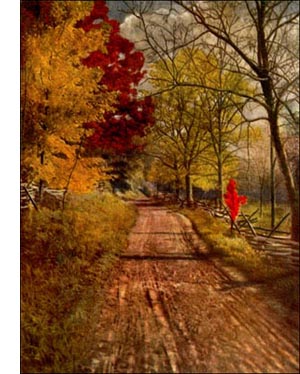Persimmon Tree
 Persimmon (Diospyros Virginiana, Linn.)-A slender. tall tree with handsome round head, rarely over 50 feet high; twigs angular, often hollow. Bark broken into thick scaly plates, dark grey or brown; twigs reddish, pubescent, becoming grey.
Persimmon (Diospyros Virginiana, Linn.)-A slender. tall tree with handsome round head, rarely over 50 feet high; twigs angular, often hollow. Bark broken into thick scaly plates, dark grey or brown; twigs reddish, pubescent, becoming grey. Wood very hard, dark brown, with pale sap wood, fine grained, tough, like hickory; not durable in soil. Buds small, pointed, reddish. Leaves alternate, simple, oval, pointed, 4 to 6 inches long, thick, shining above, paler beneath; petioles short, stout. Flowers, June, after leaves, dioecious, small, yellowish green; staminate in 3-flowered cymes, scarcely opening; pistillate solitary, wide open, with imperfect stamens.
Fruit a reddishyellow berry 1 to 1 1/2 inches in diameter, pulpy, sweet, edible when ripe; astringent when green. Preferred habitat, light, sandy soil, or moist woodlands, fence rows and abandoned fields.
Distribution, Rhode Island to Florida; west to Kansas and Texas. Uses: Worthy of planting for its rich green foliage in late summer, and its graceful habit. Comes readily from seed, but is transplanted with difficulty. Fruit shows little improvement in cultivation. Wood is used in turnery, for shoe lasts, plane stocks and shuttles.
There is no better way to fix the persimmon tree indelibly in the mind than to yield to the importunities of Southern friends and taste the fruit before it is ripe. You will be quite willing after that to wait until the frost (or whatever influence it is) mellows the puckery little plum. A traveller in the colony of Virginia wrote his friends in England about "the pessemins that grow on a most high tree." He describes them, with a fervency born of experience, as "harsh and choakie and furre in a man's mouth like allam!" Some of us say, "Amen!"
Possibly some part of the persimmon's popularity is due to its exclusiveness. Certainly no other tree keeps its fruit so far out of reach of eager hands and thirsty lips. "The longest pole takes the persimmon," is a proverb that has passed the bounds of the Southern States, and taken on a much broader significance than its originator probably intended.
The persimmon tree is not confined to the South, though its finest proportions are reached in Oklahoma forests, and it "feels the cold" in Ohio and New York. Northerners are likely to content themselves with a taste even when the fruit is at its best. It is strangely different from other things. But the Southerner born and bred knows and delights in this native fruit. The Negro revels in it, and begrudges the opossum all he steals, forgetting that a 'simmon tree when fruit is ripe belongs to the first comer. "'Possums an' 'simmons come together, an' bofe is good fruit." This statement sums up the feelings of the Negro on two vital topics. The opossum camps down in the neighbourhood of a well-laden persimmon tree and fattens on its fruit; but the defrauded darkey who marked that tree for his own can afford to keep his temper. The fat 'possum on his table on Thanksgiving day is especially delicate for this 'simmon feast, with which it tops off the season. So there is no question but that he laughs best who laughs last.
The 'possum is a nocturnal beast, and he likes company. It is not unusual for three or four to be found by night up a persimmon tree, hanging on with their bare, prehensible tails, or bracing themselves in crotches of limbs, within reach of the soft sugar lumps of fruit. They are lazy, and do not climb up if enough fruit is to be found under the tree to satisfy their appetites. In a near-by rail heap or a hollow tree the opossums sleep off the effects of heavy feeding, and return to their quest with zeal the following night.
The following, from high authority, is conclusive: "Anyone who has hunted quail through the Carolinas in January or February, when the fruit still hangs on the trees (as it occasionally does in the woods on young trees only six to eight feet high), knows that toward the end of a long day's tramp no more delicious or refreshing morsel can be imagined than these persimmons. They are thoroughly ripe then, entirely without bitterness or astringency, sweet, rich and juicy."
It is tannin in the fruit that gives it its astringency. This is gradually withdrawn, probably quite independent of the action of frost. The orange colour comes to it long before the fruit is ripe.